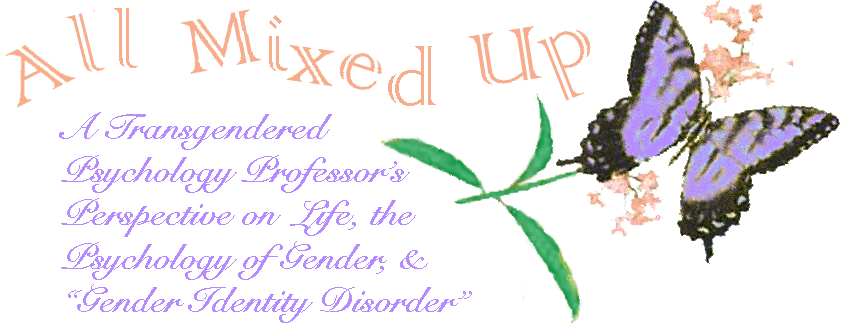
|
|

|
These are Dr Watson's gender disorientation and indecision scales applied to biological males. It's interesting to compare this table to Kinsey's Gender Disorientation Scale (below).
Gender Identity: Feminine identification only with acting out sexual fantasies.
Gender Role: Normal Male. Cross-dressing intermittent and private.
Eroticism: Genital-heightened arousal when cross-dressed.
Biological Feminization: No desire.
Conflicts: Guilt over normalcy, spousal disapproval.
Desire for Re-assignment: Not considered.
Treatment: Provide information and reassurance. Couples therapy. If impulses are ego-alien use behaviour modification, setting limits on cross-dressing sufficient to control guilt but enough to allow emotional relief.
Gender Identity: Appeal for Femininity may spill over into non-sexual life.
Gender Role: Cross-dressing more pressured, fetishistic and exhibitionistic. Intermittent relapse of intense need to act on feminine impulses related to stress alternating with reduced desire.
Eroticism: Genital-some breast.
Biological Feminization: If impulses ego-alien may use spironolactone to reduce libido.
Conflicts: Guilt and sexual performance anxiety, threatened masculinity fear of aging.
Desire for Re-assignment: Fleeting under stress.
Treatment: Insight-oriented psychotherapy to identify and modify sources of stress. Negotiate compromise in transvestitic behaviour such as dressing under male clothing.
Gender Identity: Ambivalent gender identity. Value male sex organs but feel feminine. "She-Male"
Gender Role: Dresses as much as possible depending on life circumstances. Dressing not necessarily sexual. Impulses often intensify with age and may crystalize into a transsexual picture.
Eroticism: Genital and breast.
Biological Feminization: Spironolactone for demasculinization + gynecomastia. Some may need hormones for emotional balance.
Conflicts: Confusion and personality disorganization, dual personality with male and female names and disassociated personality components.
Desire for Re-assignment: May consider late if very inadequate as males, dependent on commitments.
Treatment: Integrative psychotherapy to stabilize androgeny. Support for re-assignment if appropriate.
Gender Identity: Feel female but able to supress until age 30-50. Increasing dichotomy with age.
Gender Role: Try macho lifestyle to compensate. Increasing depression and anxiety over time. Never comfortable as males.
Eroticism: Genital if fantasizing self as female. Low libido.
Biological feminization: Requested late or intermittent.
Conflicts: Guilt, loss + fear of passing. Fear of rejection. Confused sexual orientation. Desire for
Re-assignment: Re-assignment hoped for, often attained.
Treatment: Supportive psychotherapy for symptomatic relief, family therapy, education group for stabilization of female identity.
Gender Identity: Total gender inversion. Never able to supress femininity. Feminine boys.
Gender Role: Dressing insufficient relief. Cross-live early.
Eroticism: Often asexual.
Biological Feminization: Urgent request. Late teens, early 20's.
Conflicts: Stigma of re-assignment. Family and cultural attitudes.
Desire for Re-assignment: Urgently requested. Self-mutilate if too long frustrated.
Treatment: Education support and family therapy. Assisting process of re-assignment.
|
|
|